In the first days of a baby's life, a newborn's skin may suddenly become covered with small pimples. These pimples can have different appearances - they can be red, white, they can cover certain areas of the skin, they can appear on the face, or on the whole body. In order not to puzzle over why pimples appeared on the face of a newborn, you need to know about the most common causes of their appearance, and, depending on the cause, select treatment. In general, there are acne that require treatment, and there are those that go away on their own.
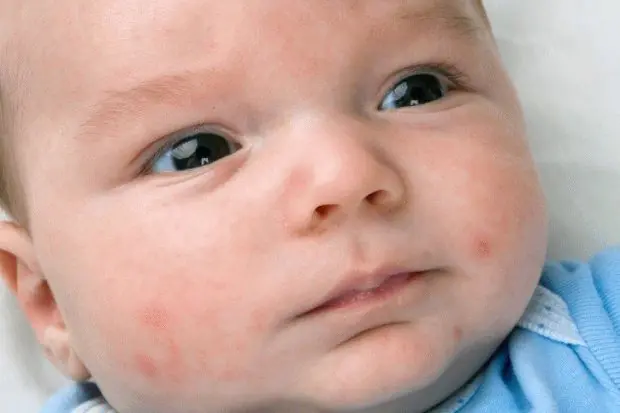
Causes of pimples
White pimples
- Newborn acne
An excess of maternal hormones in the child’s body.
After birth, the child’s body is saturated with maternal hormones, which affect the condition of the skin, because of this, children may develop a rash (ghormonal acne). This phenomenon has a scientific name - neonatal acne. Most often the face area is affected, less often other parts of the body. Acne does not require treatment, the only thing necessary is to keep your skin dry and clean. Acne is not contagious and is not a sign of poor hygiene. The main sign of acne is localization in the face, neck and scalp.
Excessive activity of the sebaceous glands.
Immediately after birth, the glands are activated, which is where pimples appear on the baby’s face. These pimples have the appearance of acne that cover large areas of the skin. The rash usually appears a week after birth and lasts about a month. There is no need to worry if the pimples on the face do not cause discomfort to the newborn baby - they do not itch, do not fester or become inflamed.
What pimples look like - they look like accumulations of pus under the skin of a whitish-yellow color (the base is red, the tip is white).
Video to watch:
- Milia
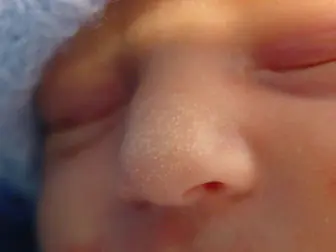
Small white pimples on the face of a newborn (white dots the size of a pinhead) are milia, an accumulation of secretions in the sebaceous glands (blockage of the sebaceous ducts). They go away on their own and cannot be squeezed out. clean with cotton swabs, treat with alcohol solutions, because You can get an infection and thereby cause an inflammatory process.
Red pimples
- Allergy
A common cause of red pimples is an allergic reaction to a product eaten by the mother. (through breast milk, the baby receives not only nutrients, but also allergens. Read about the nutrition of a nursing mother), or the formula that is fed to a newborn. To prevent allergies, a nursing mother should keep a diary in which she will write down everything she has eaten and the time when she ate this or that product. Typically, 18 hours after eating an allergen, pimples may appear on a newborn's cheeks (and sometimes all over the body). In this case, the product is removed, and if the cause of the allergy is the mixture, then it should be replaced with another.
Allergies can also be caused by washing powder that is used to wash your baby’s clothes. Remember that a child’s skin is very delicate, so baby clothes should only be washed with powder or gel that is marked “hypoallergenic.” Allergies can also be caused by animal fur, flowering plants and other external irritants.
The allergy manifests itself in the form of red spots with small rashes and crusts that peel off.
If red spots (pimples) appear on the newborn's face, you should consult a doctor. Allergies require treatment.
Video to watch:
- Prickly heat
Clothes that are too hot, the air temperature in the child’s room is high, excessive "wrapping" - all this leads to the fact that the child begins to sweat. Skin that is constantly in a state of moisture becomes covered with acne. Acne first appears in the neck area, then it can spread to the face. To avoid the appearance of prickly heat, you need to maintain a constant air temperature in the room where the newborn is located - 18 - 22 degrees Celsius. It is advisable to dress the child only in clothes made from natural fabrics, according to the weather, and not to overheat.
- Dysbacteriosis
This is another reason for the appearance of pimples in newborns. Look at the symptoms and causes of dysbiosis.
To treat or not to treat
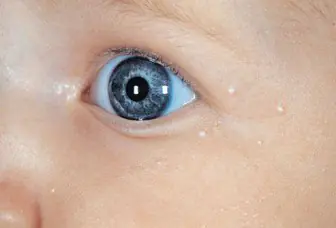
In most cases, the small white pimples (hormonal breakouts) go away on their own, so mom just needs to be patient. By about 2 months, most babies can already boast of soft, smooth skin without any acne.
Never squeeze pimples; this can seriously damage the top layers of the skin, cause infection and leave scars.
All doctors advise that if a rash or pimples appear, you need to consult a specialist; only a specialist can make the correct diagnosis.
Can:
If you still want to alleviate the condition of your baby’s skin, the simplest and most proven method is:
- Wash your child with boiled water 2 - 3 times a day;
- bathe the child in a weak solution of potassium permanganate;
- or bathe your baby in a series (bathing in various herbal decoctions). Sequential baths gently care for baby skin. Before daily bathing, add a brewed series to the bath (a large cup per bath) and bathe the child as usual;
- wipe the face and affected areas of the skin with a decoction of string or chamomile;
- It is necessary to ensure proper skin care (link to article below).
It is forbidden:
Do not use fucorcin, potassium permanganate or brilliant green for treatment, do not use alcohol-containing lotions or solutions, as these products will not cure acne and can only harm the baby’s health. No need to use: fatty oils and ointments, powder, calendula tincture, hormonal ointments, lactic acid bacteria or adsorbents (smecta), antibiotics, antihistamines. We repeat - squeezing pimples is prohibited!
Prevention
Most pimples in newborns are not considered dangerous and by following simple rules you can prevent their occurrence:
- A nursing mother should monitor her diet (what not to eat);
- For IV, monitor the reaction to the mixture;
- Proper hygiene and child care is necessary;
- Give your child air baths;
- Wash baby clothes with special powders.
If any acne or rash appears, you should immediately consult a doctor. The diagnosis should only be made by a specialist. There are a huge number of varieties of rashes that only a doctor can recognize.
Often, for severe and long-lasting acne, doctors prescribe medications such as Panthenol, Bepanten, Zinc ointment.
On the topic of skin problems:
Video: acne / allergies
Infants are under special control and attention from adults. Any changes in behavior and health in most cases become noticeable immediately, especially if it is related to the face. Pimples on the face of a baby are not uncommon.
Causes of skin changes not caused by disease
Small pimples may appear on the head, under the eyes or in other parts of the body already in the maternity hospital. In the first month, such rashes go away on their own.

- Most often, red or white small pimples can appear in the first month in infants on the head or face. Children fed with breast milk receive hormones from their mother, which cause skin changes.
- An allergic reaction to components of the mother's diet if the child is breastfed. The appearance of pimples can be caused by an incorrectly selected mixture or improper dilution during artificial feeding.
- Perhaps this is a skin reaction to climate change.
- Red formations on the skin may be a sign of heat rash. Often a child is dressed too warmly at home and outside.
- Skin reaction to frost and wind.
- Use of cosmetics.
- Disorders of the intestines (for example, dysbiosis).
Diseases that are accompanied by skin rashes
Pimples on a baby's head, neck or face may indicate an infection (measles, scarlet fever) in the body. The main symptoms include a deterioration in the child’s well-being—fever, poor appetite.
During measles, small pimples appear that gradually spread throughout the body. On the first day of the disease, red rashes appear on the neck and face. In the following days, other parts of the body are covered.
During chickenpox, red pimples appear not only on the face, but also on the head.
The rash spreads throughout the body, accompanied by fever and other symptoms (cough, runny nose).

With such a serious disease as meningitis, red pimples may appear throughout the body, which are connected to each other. This indicates the spread of the virus. The child feels unwell, lethargic, and the temperature rises.
White, red and colorless pimples can appear with serious diseases such as rubella, eczema and herpes. Therefore, you should not take a wait-and-see attitude, but seek help from a specialist.
Types of skin rashes
Pimples can vary in color, extent of distribution and size.
White pimples are usually not inflammatory in nature - they are small, isolated rashes. In the center of each pimple there is white content. They may appear as early as the first month of birth.
Most often, white pimples are localized on the forehead, chin, cheeks, and under the eyes.
White pimples can occur due to:
- influence of mother's hormones;
- adaptation of the child to new conditions;
- immaturity of the sebaceous glands;
- allergies to food or clothing.
As the child grows, sebaceous ducts form and the white pimples disappear on their own. There are no scars or wounds left in their place.
Usually white rashes do not cause pain, do not itch or bother the baby. They go away on their own by the age of two months.

Red rashes on the face, neck and under the eyes occur most often in infants. In most cases, they do not cause discomfort, but they should be treated immediately upon discovery. Only a doctor will prescribe correct and adequate treatment.
Red pimples may appear for the following reasons:
- Diathesis. Allergens can include household chemicals, food, pets, and feathers.
- Hormonal changes in the body (acne appears on the neck, cheeks). In the center of each pimple, purulent contents may be observed.
- Excessive wrapping leads to excessive sweating, which leads to skin changes.
Diathesis is a very common occurrence among infants. The rash that appears with this disease is itchy. The child constantly touches his face and sleeps poorly.
If the child is not properly cared for, pimples may also appear on the head.
Therapeutic measures
In some cases, acne in infants does not require special treatment and goes away on its own within a few days after it occurs. If this does not happen, you should not self-medicate - you need to consult a pediatrician. Based on the initial examination, he will decide on additional examination methods or refer you for consultation to other specialists. You may need to be examined by a gastroenterologist, allergist, or dermatologist.
What parents need to do
- Wet the rash areas as little as possible.
- The first month you need to boil water for all water procedures. It should be cooled to the required temperature before use.
- Do not use cosmetics or allow them to come into contact with the damaged area of the skin.
- You can make decoctions from medicinal herbs (chamomile, string). Lotions from such decoctions will help relieve inflammation, itching and swelling. Moreover, with anti-inflammatory and antimicrobial properties, the herbs can stop the spread of pimples on the face.
- Do not use alcohol-based solutions or lotions.
Without consulting with specialists and taking a number of measures, you should not use antihistamines and hormonal drugs.
All actions to treat pimples on a baby’s face should be carried out carefully, without unnecessary pressure or friction.
Prevention of skin disorders in children
It is necessary to carefully observe hygiene procedures and diet. Only in this case will the child’s skin be smooth, soft and even. In addition to these actions, you can add the following preventive measures.
- Be sure to daily ventilate the room where the child is.
- A properly organized place where the baby sleeps: in the first month of life, you should use a diaper instead of a pillow, there should be no bright light in the room, you should get rid of feather bedding.
- Clothing should be made of high-quality hypoallergenic material.
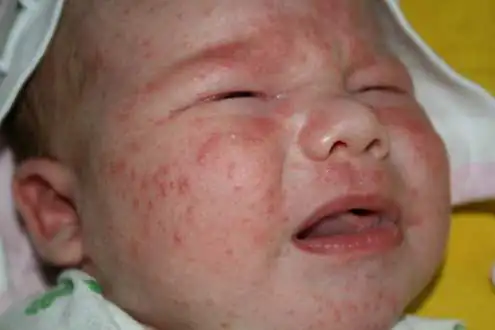
- In the first month, clothes should be chosen without unnecessary seams and decorative details. Before each use, it must be ironed on both sides.
- Clothes should be washed separately from adult laundry. You need to have a special hypoallergenic powder available.
- To relieve your facial skin from excessive dryness, you need to ensure the correct level of humidity in the room.
Skin diseases associated with the appearance of various types of pimples in the first month of a child’s life, in most cases, do not pose any health hazard.
But when they appear, you should more closely monitor the behavior and condition of the baby. If warning symptoms occur, you should consult a doctor.
Necessary information for mothers on newborns and infants
Hello, dear readers! This article will be of particular interest to young parents and those who are still preparing to become parents. And we will talk about small pimples on your baby’s cheeks in the first month of life.
Agree, if you do not have the necessary information, it is easy to sound the alarm when you see some kind of rash on the face of a newborn baby. But don't panic. Now we will tell you why.
Reading Signals
Based on statistics, almost all newborn children have a rash. But there are different reasons and types. First you need to pay attention to the color of the pimples.
If they are white, then there is no particular cause for concern. Such rashes can be caused by residual maternal hormones in the newborn’s body or by the sebaceous glands not yet functioning properly. Gradually the rash will go away on its own. Of course, color alone is not enough. It is worth paying attention to the presence of itching, peeling and inflammation of the skin. If you have such symptoms, you should immediately consult a doctor.

If you find red pimples on your baby’s body, neck or face, then you should be wary. Check immediately to see if he has a fever. If yes, then there is some kind of infection and an immediate visit to the pediatrician is required. It’s better not to delay this - a child’s body is not as strong as an adult’s.
If there is no temperature, you should pay attention to the following points:
- your diet over the past 24 hours;
- what kind of washing powder is used;
- does the child have problems with bowel movements;
- Is he sweating too much?
Sources of the problem
The most common causes of acne in infants are prickly heat, allergies, dysbacteriosis and infections.
Miliaria occurs most often due to excessive efforts of parents. The child should always be in a comfortable room temperature, regularly take air and sun baths and not overheat.
Clothes should be made of good, high-quality and natural material. The peculiarity of prickly heat is that it appears most often on the body, in places of natural folds and depressions.
Allergies usually manifest themselves on the face. It can be caused either by formula, if the baby is bottle-fed, or by food eaten by the nursing mother. During breastfeeding, mothers are especially advised to regularly record all the food they eat.
If you suspect an allergy in a child, you should pay attention to foods eaten approximately 18 hours ago. It is also worth paying attention to the products used for washing clothes with which the child comes into contact, the presence of dust, pollen, and animals. In children, all this causes a negative reaction much more easily than in an adult. If you suspect an allergy, we also strongly recommend that you consult a specialist.

Dysbacteriosis in a newborn occurs for completely natural reasons. As soon as they are born, children have completely sterile intestines. Gradually it is populated with normal microflora necessary for good digestion.
If your child has a stomach ache, is restless, screams, has bad, foul-smelling stools, is vomiting, or notices a white coating on the oral mucosa (called thrush), do not try to solve the problem yourself. This requires qualified help.
We have already written about infectious diseases above, so let’s now look at general recommendations for caring for children’s skin.
Recommendations
The first thing to note is that you should never try to squeeze your child’s pimples. They must go away on their own, otherwise you can damage your baby's skin with consequences that will last a lifetime.
- Under no circumstances should you treat the rash with alcohol or alcohol-containing solutions. And you need to be extremely careful with aqueous solutions.
- It is allowed to use a highly diluted solution of potassium permanganate. You can bathe your child in it. It is also useful to use a decoction of string or chamomile to treat acne or for baths.
- You need to wash your baby's face several times a day with boiled water, especially after feeding. Under no circumstances should you over-wrap him, use underwear and clothing only made from high-quality material.
- Use hypoallergenic powders for washing.
- Also keep a diary of the timing and content of your meals.
- Change your diaper promptly and bathe your baby every evening.
- A big plus would be adding a herbal decoction to the bath. And be sure to thoroughly wash off all products used to wash your child’s skin.
- Take sun and air baths - this is necessary to harden your child, develop immunity and prevent vitamin D deficiency.
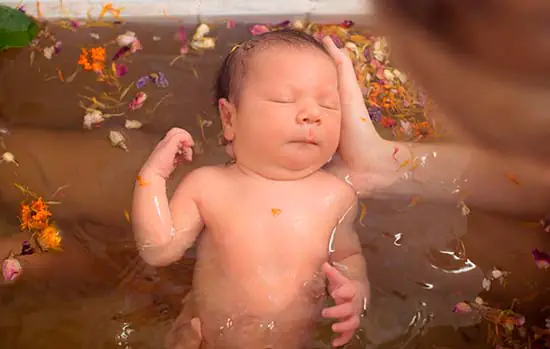
That's all the advice you need, dear readers. Take care of yourself and your children, because they are our future. Stay with us, don't forget to subscribe to news and share information with your friends and family. See you soon!




